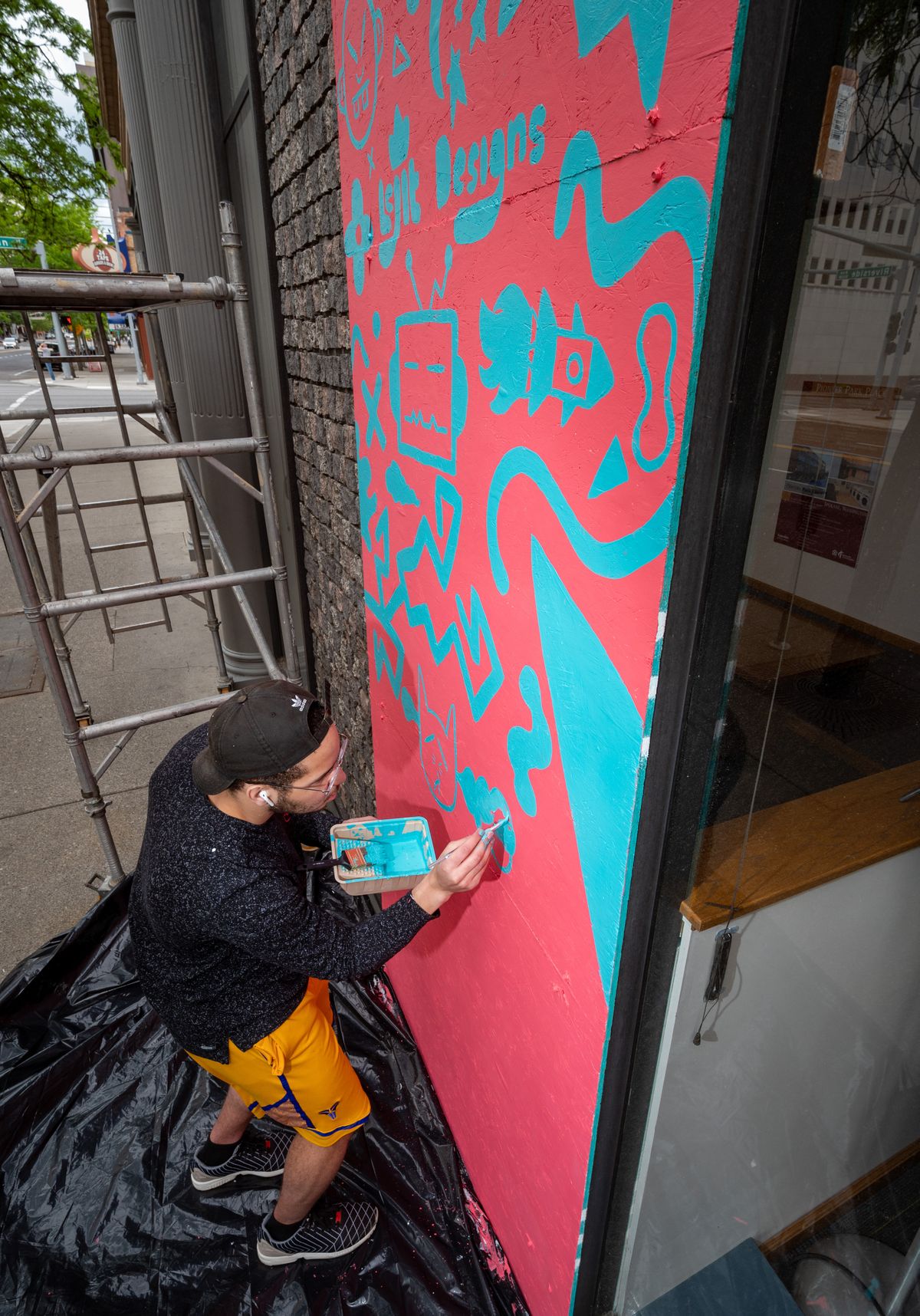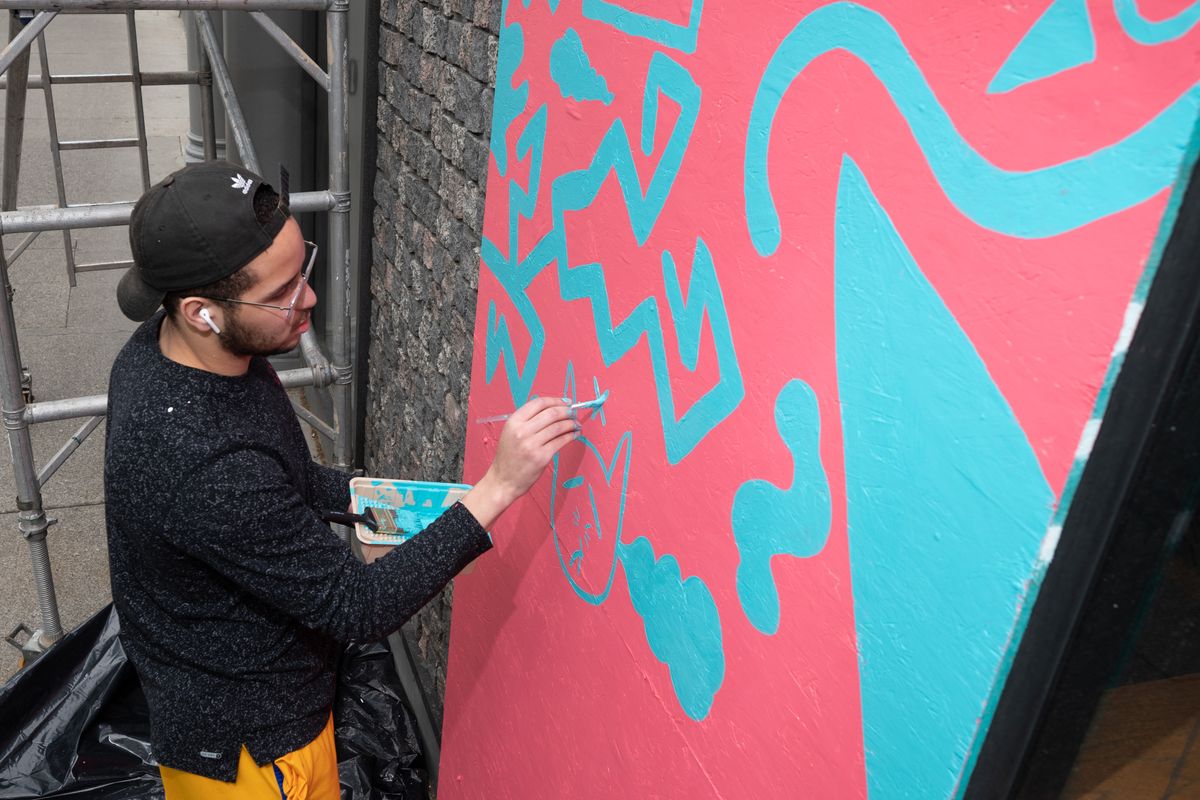Murals help heal downtown’s broken windows

The display window in Ashley Brownlee’s store was not broken by the same agitators who disrupted the protest in downtown Spokane. Rather, the first break came from a projectile, likely a rubber bullet, fired by police trying to quell those agitators.
Brownlee, owner of Garland Resale on Howard Street, left her store late that Sunday night as the protests were heating up – tear gas was rolling down the streets, and she didn’t want to get hit. She’d been home less than 15 minutes when she saw her storefront on the news.
Checking her security cameras, “all I saw was broken glass,” Brownlee said.
She raced back to the shop, where she stayed out front with a broom, chasing off any would-be looters until the wee hours of that morning.

Though the first break was later determined to have been made by a police projectile – for which the Spokane Police Department has agreed to reimburse Brownlee – opportunists saw a chance and kicked in the rest of the window. Brownlee said camera footage showed them rifling through her displays, but they didn’t take anything.
By the morning, Brownlee felt her shop was safe. But she was left with an ugly broken window, and then an unsightly sheet of plywood where the window once was. She decided to brighten the mood by painting the plywood with something beautiful: poppies, which spring up when you least expect them.
“My whole shop is me doing things I like,” Brownlee said. “It’s a representation of myself. I wanted to paint flowers because I hated the plywood, but it’s also a reminder I’ve been through a lot – a fire, a flood, and now this.”
Brownlee wasn’t the only downtown business to sustain damage during the protests, though she was the only one whose damage was not caused by agitators involved with the protest. The sheets of plywood temporarily patching holes at Home Street Bank, the former Observatory and the Nike store in River Park Square, among others, were like ugly black eyes after that rough night.
“So we thought, why not fill downtown with as much art as possible instead?” said Melissa Huggins, executive director for Spokane Arts, a nonprofit that connects artists with opportunities.
Huggins, in conjunction with Downtown Spokane Partnership, started reaching out to businesses that sustained damage. The goal was to pair them with local muralists who could cover those sheets of plywood with positive and beautiful art, at least until replacement windows arrived. Spokane Arts would pay each artist a small stipend s.
The idea came in part from larger cities like Oakland and Minneapolis, where local graffiti artists decorated boarded-up businesses with images of love and solidarity during their own protests and throughout coronavirus shutdowns. Huggins said Spokane Arts wanted to encourage something similar locally, in line with their motto of “the more art, the better.”
“It is such a fantastic way to provide a canvas for the city to respond to the current climate and capture this moment in time,” Huggins said. “And it doubles as a beautification effort, because boards just look so grim and sad.”
Plus, Huggins added, the murals would deter graffiti artists from tagging the blank boards with other imagery that wasn’t so positive. Other businesses had a similar idea but operated independently from the Spokane Arts project, including Garland Resale and Spokane Exercise Equipment, which recruited local graffiti artist Desmond Boston through an open Facebook call.
Huggins found several Spokane artists with ideas for murals and paired each of them with a business. There were no restrictions, except there couldn’t be any text beside their signatures.
Collaborative duo Susan Webber and Shelby Allison were tapped to create a piece for the Nike store, downtown’s most prominent looting site. Allison said Huggins contacted them the Wednesday after the protests. By Saturday, she and Webber were putting paint to plywood.
“It all happened really quickly, so we didn’t have much time to plan,” Allison said. “It kind of just happened as we were painting. We texted throughout the week to brainstorm ideas, but really we just went in and bounced off of each other.”
Aligned in message, the two combined their styles to create a work rich in symbolism. Webber said they hoped to say the names of victims of police brutality without words.
Webber believes art is what it means to the viewer, and she rejects explaining every motivation for her work. She said each component carries meaning as they worked. For example, Allison said some of the flowers wreathing the mural’s borders are delphinium, symbolizing growth and change. The figure at the center is intentionally ambiguous, but Webber wanted it to be innocent, childlike.
Webber and Allison both said they were a little nervous, wondering if antagonistic passersby would try to pick a fight. But Webber said the real-time response was “99% positive,” apart from a small handful who thought the artists were vandalizing Nike’s storefront.
“Being there during the second protest on Sunday was powerful,” Webber said. “We couldn’t go because we were working, but I feel like the mural was our great big protest sign.”
Allison and Webber donated their stipend to the Innocence Project, which works to free the wrongly convicted from prison using DNA testing, and the Spokane branch of the Bail Project, a national group that bails people out of jail while awaiting trial.
Webber said she and Alexander wanted to contribute to causes that address systemic issues related to the goals of the Black Lives Matter movement.
“We want to put our money where our mouth is,” Webber said. “Or at least where our paint and hands are.”
Editor’s note: This article was changed on June 11, 2020 to correct information about what Spokane Arts will be pay for. The organization will pay artists a stipend for their work. They will not pay for the replacement costs of the windows.